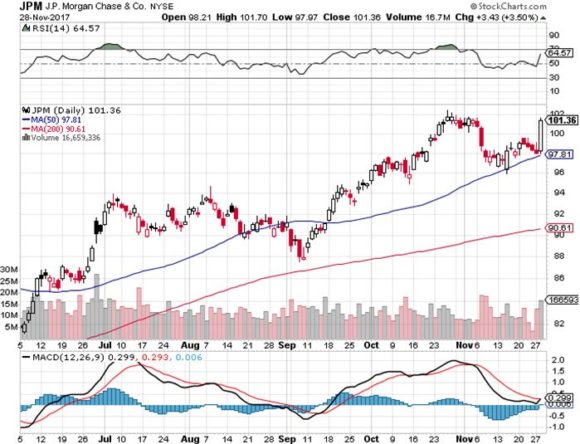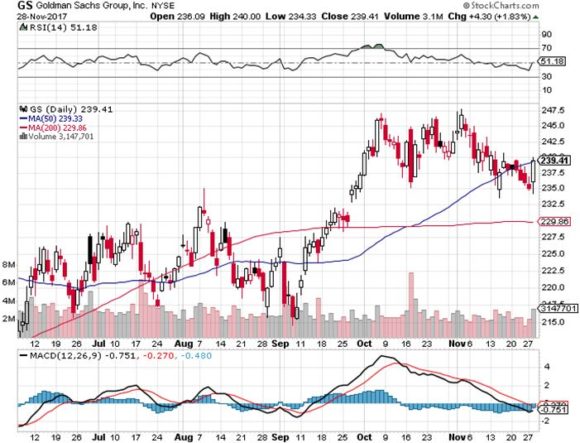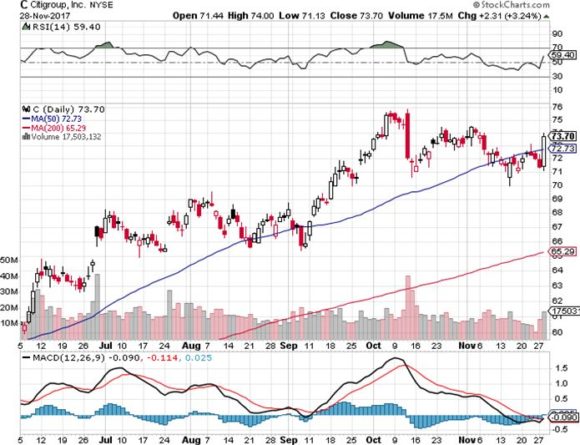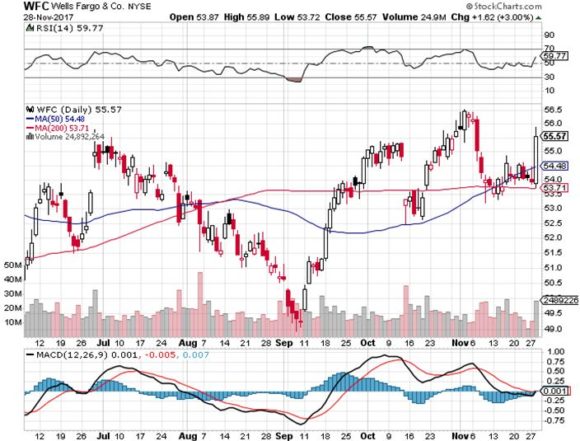Anyone who has listened to one of my Mad Hedge Global Strategy Webinars over the past six months has heard me recommend the same sector as the top market performer for the next three years:
Financials.
I am sticking to my guns, and it's not too late to get in.
If fact, I think leading names like Goldman Sachs (GS), JP Morgan (JPM), Citicorp (C), Bank of America (BAC), and Wells Fargo (WFC) could double over the next 2-3 years, and continue rising until the next recession hits.
Today, the market agreed with me in spades.
You can thank nominated Federal Reserve Governor Jerome Powell for the price action, who appeared in front of Congress today. The more he spoke, the higher bank shares rose.
He did his best to appear as a clone of outgoing governor Janet Yellen, who preceded over one of the most rapid increases in bank profits in history.
And what's good for Janet is good for the country.
One of the great appeals of the bull case for banks is that it is not all that hard to figure out.
I love banks, especially American ones.
I like those imposing, monumental edifices. I am attracted to those smooth marble surfaces. Those wrought iron grills at the teller windows are not to be trifled with.
They all reek of safety, stability, and certainty. What better place to park your life savings. And I never hesitate to grab one of those free breath mints on the way out the door.
What?
Didn't they get rid of those during a 1980's cost cutting binge? You always know that when they have to dump the breath mints to preserve their profit margin, there's a problem.
The airlines did it 40 years ago, and look what happened to them.
However, today, banks and financial shares in general offer some unique investment opportunities.
What is a manager to do when the stock market is at a century high valuation? You only buy cheap stuff.
What is a trader to do in a stock market characterized by rapid sector rotation? You only buy, you guessed it, cheap sectors.
Enter the banks.
You remember the banks, don't you? That was the sector that was priced for perfection in anticipation of eight consecutive quarter point interest rate raises starting in December 2015.
It only took a 10% stock market correction to rain on that parade, as the prospect of any further rate hikes was put on ice. Back stocks plunged 40% in a heartbeat.
Now that the April Open Market Committee minutes have put a rate rise back on the table, we're seeing that movie replayed one more time.
This time around, banks have attractions that were missing in past cycles.
Oversight is now at record levels of intensity.
Nearly a decade of new share issues has brought bank capital to record levels, and liquidity is at an all-time highs.
Book values are growing at a decent pace.
Energy loan losses were wildly over exaggerated by the rumor mill.
Share valuations are discounting a full scale recession that, worst case, is at least 2-3 years off. Earnings are at record highs.
Efficiencies are growing by leaps and bounds. One of the reasons that New York City has had the worst residential real estate market for the past couple of years is that bank layoffs have reached the hundreds of thousands.
Bank subleasing of office space has been so prodigious that is even starting to drag on the red-hot San Francisco commercial real estate market.
In fact, you could write off an entire new housing crisis now and still have more capital left over than last time.
Stocks could double over the next interest rate cycle. They offer a double discount in price to book value (70%) and earnings multiple to the main market multiple (9X versus 19X). Dividend yield are the highest in history.
Even Facebook (FB) and Apple (AAPL) are unlikely to beat that.
The fines and penalties that came out of the financial crisis are now a distant memory. They are even getting reversed in some cases, thanks to a friendly administration.
Bank shares are in fact a levered put on the bond market (TLT) and a call option on interest rates ($TNX).
There has been a lot of uninformed chatter about fintech eating the banks' lunch. But the reality is that the staggering regulation imposed on the banks by Dodd-Frank and the Treasury will act as an unassailable moat protecting the industry.
My guess is that entrepreneurs, developers, and coders will take one look at the morass of new rules and walk away to find some other industry to prey upon (real estate brokerage?).
The long-promised breakups of the big banks will never happen, lest the US give away its competitive advantage with the rest of the world. If they do, it will unlock massive shareholder value, enabling the shares to double yet again.
You could diversify and buy the basket through the Financial Select Sector ETF (XLK) (click here for their prospectus).
The smart regional bank play here is Comerica (CMA).
As a result of all of this, bank stocks are offering the lowest entry point in a generation.
The big question is if this is yet another bull trap and fake out with the banks, or whether this is the beginning of a long-term sustainable trend up.
We may well find out on December 13 when the Fed announces its next 25 basis point interest rate rise, or not?
Will Yellen's final commentary be hawkish, dovish, neither, or both?
If's she's smart, she'll talk about the weather.
Sticking to My Guns on Financials







